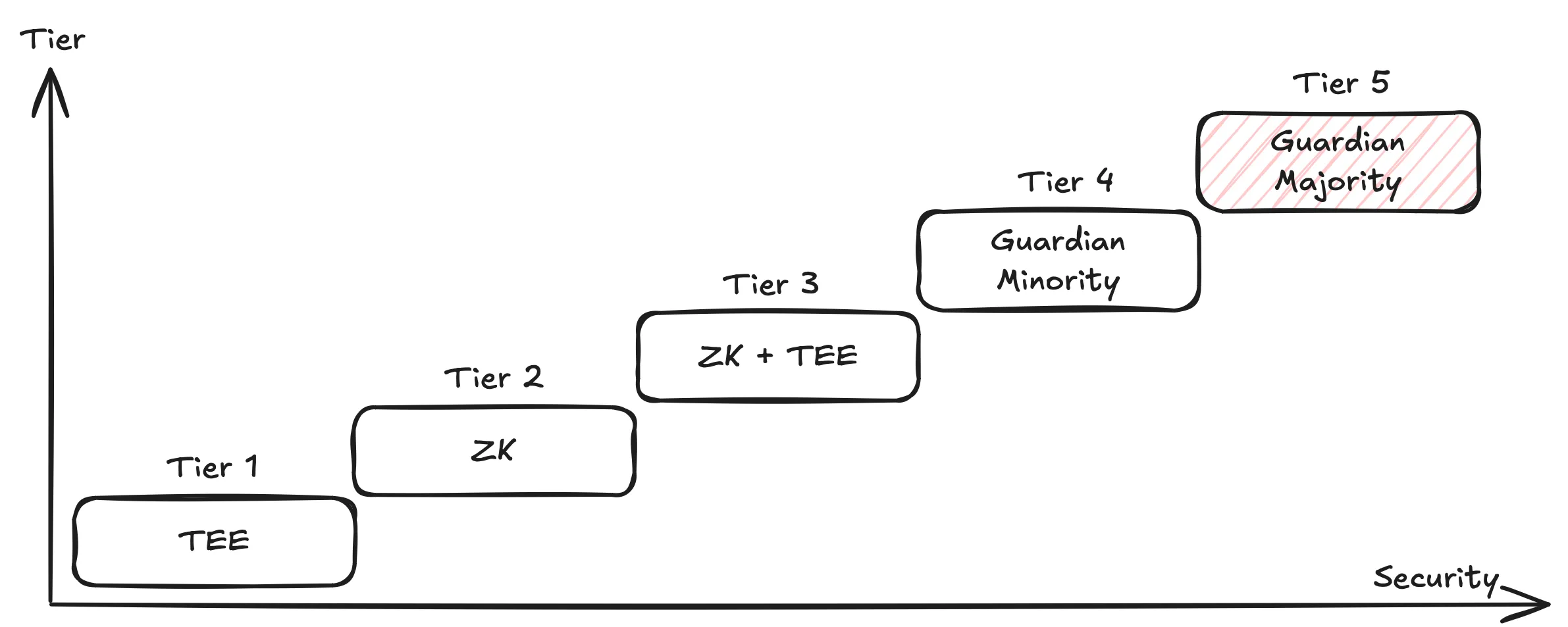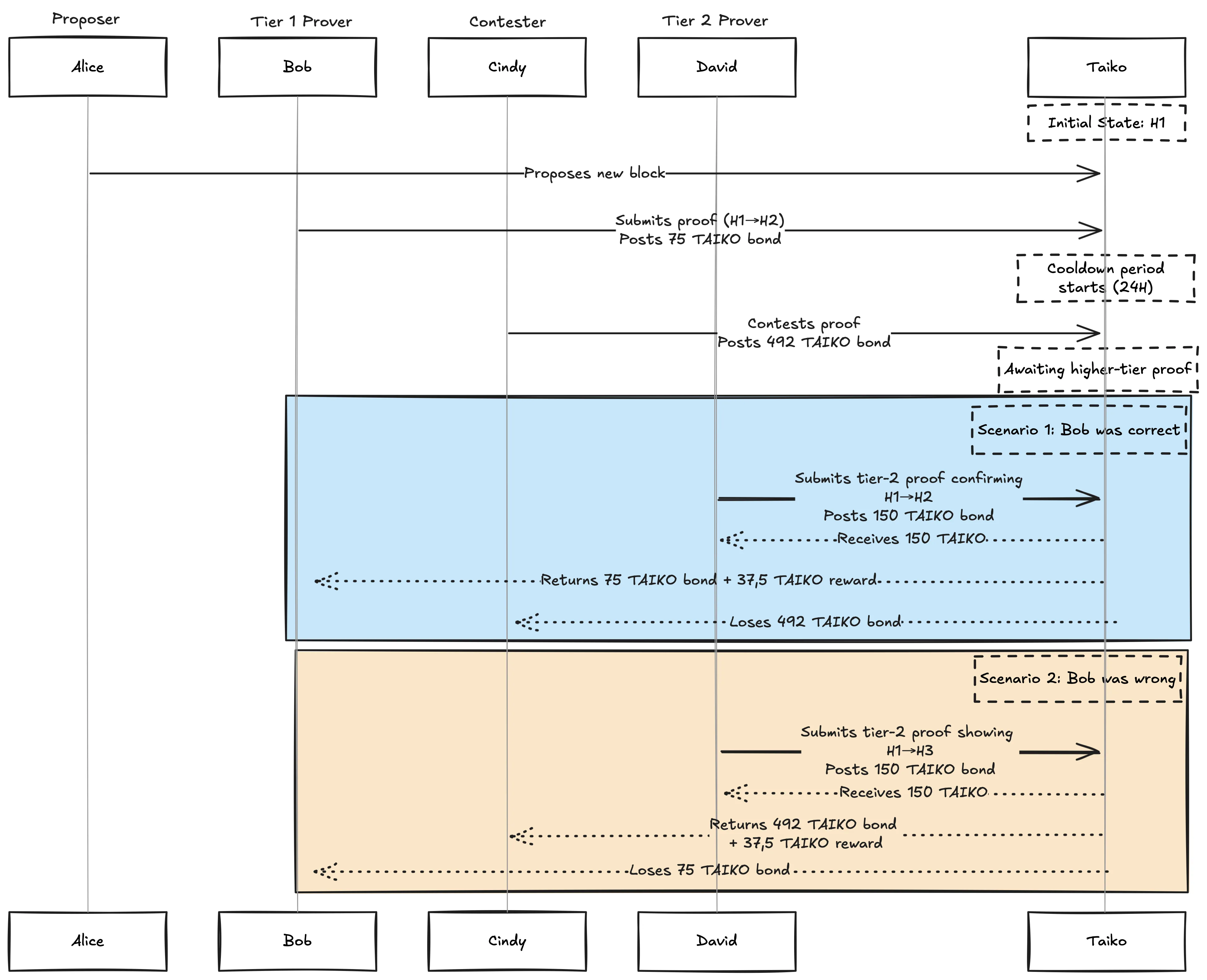Contestable Rollups
Taiko Alethia employs a Based Contestable Rollup (BCR) architecture, combining based sequencing with multi-proof validation to ensure a high degree of security and decentralization. Unlike centralized rollups that can tolerate certain risks due to their controlled environments, Taiko is fully permissionless. This necessitates a robust multi-proof contestation mechanism to prevent malicious behavior and ensure finality.
In a BCR, every proof submitted undergoes a challenge period where any participant can contest it. This ensures the validity of state transitions while allowing the system to dynamically adjust based on security and cost considerations.
Hierarchy of Proofs in Taiko Alethia
Taiko Alethia supports a multi-tiered proof system:
-
Tier 1 - TEE (Trusted Execution Environment) Proofs:
- SGX-based proofs provide a low-cost and efficient proving mechanism.
- These are fast but have trust assumptions related to Intel SGX.
-
Tier 2 - Zero-Knowledge (ZK) Proofs:
- Ensures correctness without requiring any trust assumptions.
- More expensive computationally but cryptographically secure.
-
Tier 3 - Hybrid (TEE + ZK) Proofs:
- A combination of TEE and ZK, increasing robustness.
- Allows parallel proving while maintaining security.
-
Tier 4 - Guardian Minority:
- A small set of guardian provers for backup security.
- Used in edge cases where TEE/ZK are disputed.
- Tier 5 - Guardian Majority:
- A larger multi-sig proving mechanism used as the final fallback.
- Meant to be phased out as the system becomes more decentralized.

Proof Contests and Escalation
Each proof submission in Taiko goes through a contestable validation process, ensuring high security while remaining cost-efficient.
Scenario:
-
A proposer (Alice) submits a new block.
-
A tier-1 prover (Bob) submits a proof (H1 → H2) with a validity bond.
-
A cooldown period starts, allowing anyone to contest the proof.
-
A contester (Cindy) challenges Bob’s proof, claiming the correct transition should be H1 → H3.
-
The system awaits a higher-tier proof to resolve the dispute.
-
Two possible outcomes:
- If a tier-2 prover (David) confirms Bob’s proof was correct, Bob is rewarded, Cindy loses her contestation bond.
- If David proves Cindy was correct (H1 → H3), Cindy gets rewarded, and Bob loses his bond.

Contestation Bond Economics
Contesting a proof requires putting up a contest bond, ensuring economic security. The outcomes are:
-
If the contester wins:
- The contester receives the contestation bond back and 1/4 of the original prover’s bond.
- The new prover receives 1/4 of the original prover’s validity bond as a proving fee.
- 1/2 of the original prover’s bond is sent to the DAO treasury.
- If the original prover wins:
- The original prover gets back the validity bond and 1/4 of the contest bond as a reward.
- The new prover earns 1/4 of the contest bond.
- 1/2 of the contest bond goes to the DAO treasury.
Advantages of Based Contestable Rollups
-
Permissionless and Decentralized:
- No centralized sequencer, relying on Ethereum validators for sequencing.
- Anyone can prove or contest a block.
-
Multi-Proof Security Model:
- Enables dynamic configuration of proving systems.
- Different proof tiers balance security and efficiency.
-
Economic Security with Bonds:
- Contestation requires financial commitments, discouraging spam disputes.
- Ensures incentives for provers and contesters.
- Future-Proofing with Dynamic Proofing System:
- Allows gradual migration from TEE-based proofs to fully ZK-based proofs.
- Adapts to evolving cryptographic advancements.
Learn More
For a deep dive into the BCR model, read our blog post: Based Contestable Rollup (BCR): A configurable, multi-proof rollup design.